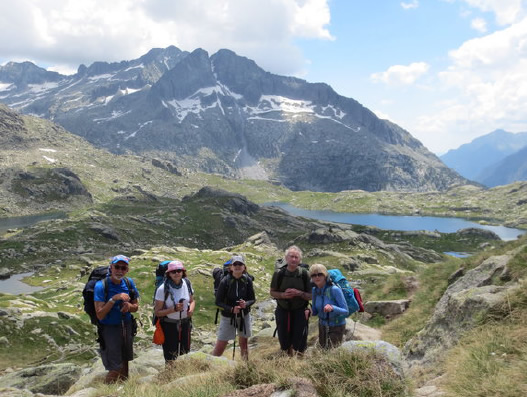
We began our six day tour of the Carros de Foch on Tuesday morning in Espot, following a longjoumey up into the Pyrenees late on the previous evening. The Carros de Foch crosses the Aigues Tortes in the Aiguestortes I Estany de Sant Maurici National Park and is one of the most beautiful parts of the Spanish Pyrenees. The national park is over 140 sq km and is brimming with hundreds of mountain lakes, cascading streams, speckled with cool clear ponds and roaring waterfalls.(Aigüestortes means twisted waters in Catalan) The Carros de Foch, otherwise known as Chariots of Fire route, is over 55km and makes a total elevation gain of over 9km, which we truly felt at times. The trail was devised 15 years ago by Miguel Sanchez i Murcia the keeper of the Ventosa refuge as a test for super athletes or sky runners as they are called, who complete the route in one day.
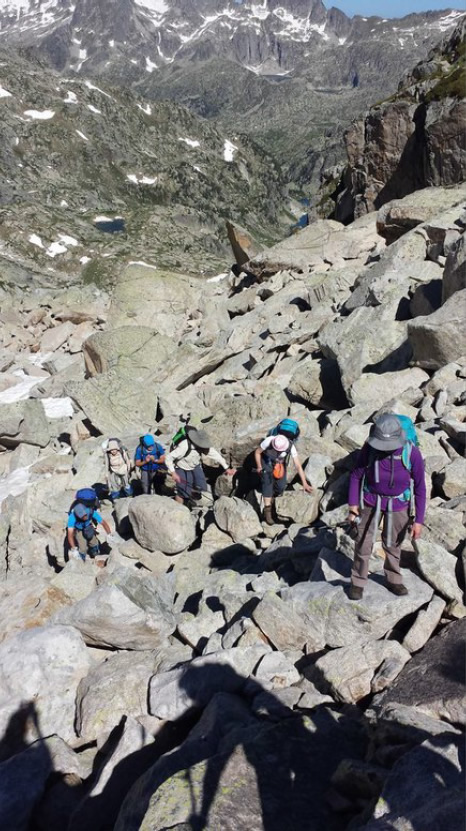
Armed with our delicious lunch from the local deli we began our trek in Espot, on a cloudy Tuesday morning, looking up in trepidation at the peaks all around us. This first 11km leg took us up along gentle tracks and paths, in the shadow of the famous landmarks the Grand and Petit Encantat (Enchanted Mountains) to the Sant Maurici lake. Much of this time was spent adjusting our bags and getting used to the unaccustomed weight we were carrying. Following a tasty lunch we headed up through woodlands passing the Cascade de Ratera arriving mid afternoon at the Refugio d'Armitages, getting in just before one of the few rain showers of the week. Being newbies to the refugio routine our guide Miguel put us through our paces and showed us the ropes of hut etiquette! The first nights were a challenge as we coped with the first days of altitude discomfort and the interesting sleeping arrangements! By day 3 we had the strategy down to a fine art with the best beds bagged by early evening.
Day Two
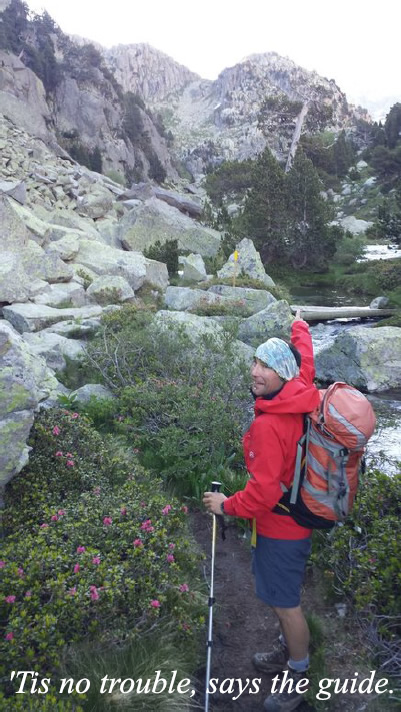
An early start to get the best of the day we headed to the Port de Ratera where we picked up the GR 11, the high Pyrenean route which traverses the Pyrenees on the Spanish side. The walking was relatively easy taking in a wonderful vista of rocky peaks all around us. Snow was still very much in evidence and provided some slippery traverses in parts en route to our second refuge - the Colomers refuge. Many of the refuges were quiet at that time and it generally made for more comfort giving us time and space to catch up on our chores.
Day Three
The day started with a climb to the Porte de Caldes, with the sun high
in the sky. We took in the spectacular views making our way down
through the beautiful lakes. There are over 450 lakes in the national
park area with the typical dark blue colour lending an almost tropical
view to the area. The general silence, without birdsong is striking in
this high Pyrenean terrain where there is very
little vegetation and
one has to look
carefully to see animal life.
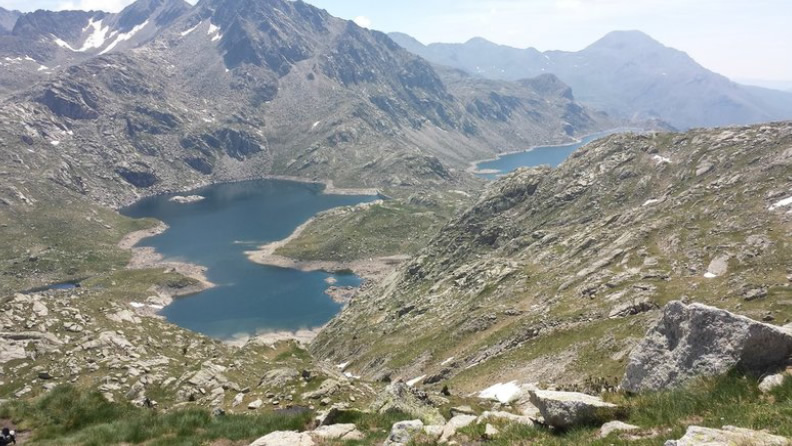 We heard
marmots frequently
during the trek with
the odd sighting of chamois.
After a good day's
hiking we arrived to the
sunny sheltered
Ventosa I Calvell refuge where we spent a pleasant few hours on the
terrace outside relaxing and doing our chores. From here we had a
lovely panoramic view down on Estany Negre and west over the
Pyrenees. At this stage we were settling into the routine of lights out
early and our bunks were a welcome place for weary bodies.
We heard
marmots frequently
during the trek with
the odd sighting of chamois.
After a good day's
hiking we arrived to the
sunny sheltered
Ventosa I Calvell refuge where we spent a pleasant few hours on the
terrace outside relaxing and doing our chores. From here we had a
lovely panoramic view down on Estany Negre and west over the
Pyrenees. At this stage we were settling into the routine of lights out
early and our bunks were a welcome place for weary bodies.
Day Four
Today was the big day that Miguel had been preparing us for all week
- the traverse of the Col de Contraix at 2,749m. This was one of the
most challenging days especially the long morning climb through the
boulder fields. There was much scrambling to reach the top but we
were well rewarded with the 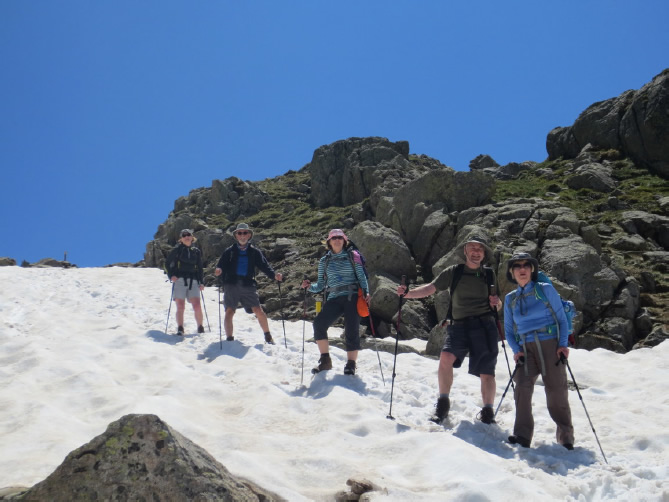 spectacular views of a moon-like world of sheer rock as far
as the eye could see. Luckily
there were good snow fields
ahead which made the descent
more interesting and easier.
Walking down through the
lower meadows and pastures
we arrived at the refuge
Estany Llong in the late
afternoon where we sipped
our coffee in the sunshine and
relaxed into the rhythm of the
evening refuge routine.
spectacular views of a moon-like world of sheer rock as far
as the eye could see. Luckily
there were good snow fields
ahead which made the descent
more interesting and easier.
Walking down through the
lower meadows and pastures
we arrived at the refuge
Estany Llong in the late
afternoon where we sipped
our coffee in the sunshine and
relaxed into the rhythm of the
evening refuge routine.
Day Five
We set out on one of the longest days through the spectacular tarn-sprinkled region. The sun was high and we had most beautiful views
of dark pools and infinity lakes as we made our way along. At lunch
we had an opportunity to swim in the refreshing water of Estany Tort
one of the largest lakes we passed. 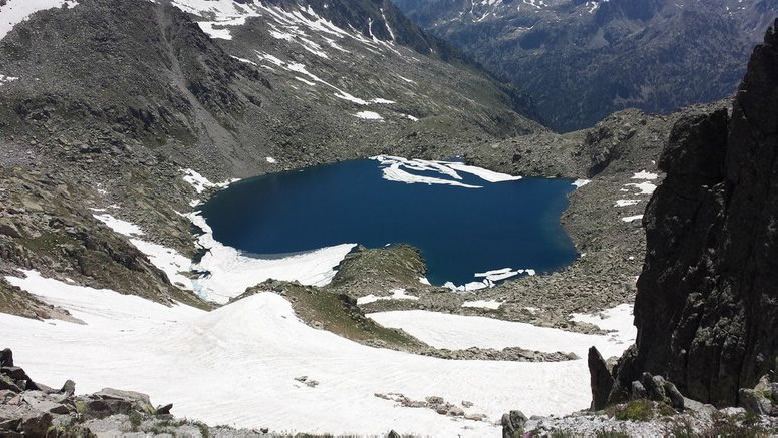 This area is an important region for
hydroelectricity and
the Colomina refuge
where we were
heading to, had been
built by one of
hydroelectric
companies to house
employees. Franco
visited the park in
September 1955 to
open a number of
these hydroelectric
power stations and later that year the region was declared a national
park by decree. The route today takes one along the remains of the old
narrow gauge train track left behind by the engineers. The walking
was refreshing and relaxing in contrast to the earlier days of steep
climbs and descents.
This area is an important region for
hydroelectricity and
the Colomina refuge
where we were
heading to, had been
built by one of
hydroelectric
companies to house
employees. Franco
visited the park in
September 1955 to
open a number of
these hydroelectric
power stations and later that year the region was declared a national
park by decree. The route today takes one along the remains of the old
narrow gauge train track left behind by the engineers. The walking
was refreshing and relaxing in contrast to the earlier days of steep
climbs and descents.
Day Six
We began our final leg from Colomina back to Espot, with an early
start in the crisp morning air. The lakes glistened in the sun as we
picked our way along the lakeshore paths and climbed to the Collada
de Capdella. We passed 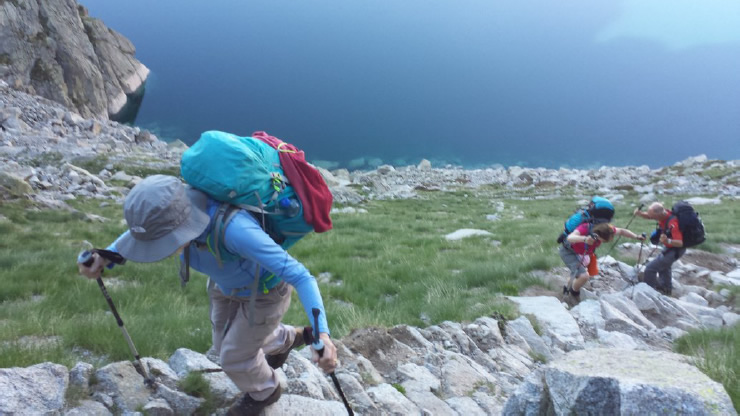 many of the sky runners
on this route as it is a
popular weekend activity
here. We stopped for
lunch at the popular
refugio J.M. Blanc to
shelter from the mid-day
heat. The afternoon heat
built as we made our way
down to Espot through
trees which provided
much-needed shelter from the developing heat wave. We spent our
final night in Rialp where we enjoyed the luxuries of life.
many of the sky runners
on this route as it is a
popular weekend activity
here. We stopped for
lunch at the popular
refugio J.M. Blanc to
shelter from the mid-day
heat. The afternoon heat
built as we made our way
down to Espot through
trees which provided
much-needed shelter from the developing heat wave. We spent our
final night in Rialp where we enjoyed the luxuries of life.
